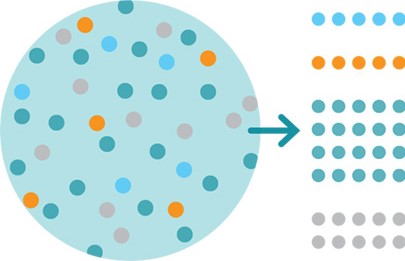What Is Cell Isolation?
Cell isolation—also referred to as cell separation or cell sorting—is the process of isolating one cell population from other cells in a heterogeneous biological sample. Targeted cells are identified, isolated, and then separated according to their type.

What are some example uses of cell isolation?
Examples of Cell Isolation
Research based on cell isolation is an essential part of many life sciences, from stem cell and oncology research to routine clinical diagnosis.
Cell isolation techniques allow scientists to perform a variety of applications, including the following:
- Capture circulating tumor cells in blood
- Conduct molecular analysis of specific cell populations
- Isolate immune cells from peripheral blood
- Preparing a sample of blood separated from plasma
- Separate bacteria from food
- Study the effects of drug candidates on cell types
- Isolate white blood cells from tissue
- Recover mononucleated cells from blood
Separating the targeted population from the rest of the sample minimizes interference and is key to identifying, studying, and analyzing specific cell populations.
What are some cell isolation techniques?
Cell Isolation Techniques
There are a variety of methods used to isolate cell populations, usually based on one or more properties unique to that cell type (size, electric charge, density, shape, protein expression, etc.).
Fluorescence-Activated Cell Sorting (FACS)
Fluorescence-activated cell sorting (FACS) technology labels cells with fluorescent markers based on internal or external characteristics of the targeted cell group. Then, the cells are identified and sorted one at a time based on the color of the marker.
Density Gradient Centrifugation
Density gradient centrifugation is a common cell isolation technique where the biological sample is centrifuged until the cell types are isolated into layers depending on their respective densities.
Magnetic-Activated Cell Sorting (MACS)
Magnetic-activated cell sorting (MACS) binds magnetic particles to cells through an antibody interaction with surface markers of the targeted cells. The cell group is then magnetically isolated from the rest of the biological sample.
Filtration
Filtration is a cell isolation method based on cell size. Using a filtration device specific to the targeted cell group’s size, smaller cells pass through the device while larger cells are trapped.
Aptamer-Based Cell Isolation
Aptamer-based cell isolation uses aptamers such as DNA or RNA to bind to targeted cells based on specific biomarkers.
Buoyancy-Activated Cell Sorting (BACS™)
Buoyancy-activated cell sorting (BACS™) is a revolutionary cell isolation technology. Microbubbles bind to cells, and the targeted cells are removed from the biological sample through flotation.
Which cell Isolation method should I choose?
How to Choose a Cell Isolation Method
Consider these questions when selecting a cell isolation technique:
- Purity: What percentage of isolated cells belong to the targeted group?
- Recovery: What is the percentage of isolated target cells as compared to the total number of target cells?
- Speed: How quickly is the cell isolation process?
- Throughput: How many cells can be isolated at the same time?
- Usability: Is the cell isolation technique reliable and easy to reproduce?
Choose the most efficient and effective method for your sample. Check out our in-depth article on evaluating different cell separation techniques.


